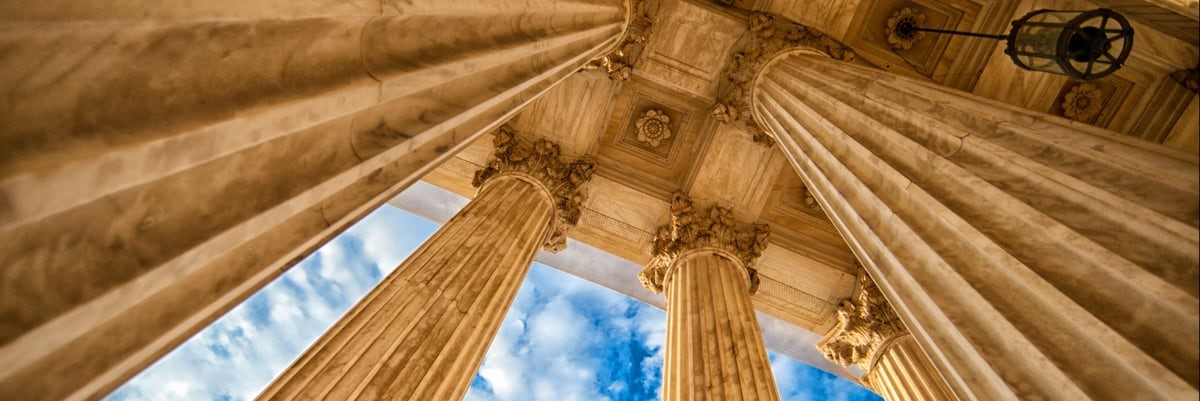Supreme Court Ruling Effectively Ends Race-Based Affirmative Action for Admissions Decisions
Legal Alerts
6.30.23

The Supreme Court’s decision in the twin cases of Students For Fair Admissions, Inc. v. President and Fellows of Harvard College., No. 20-1199, and Students for Fair Admissions, Inc. v. University of North Carolina, No. 21-707 (collectively referenced as “SFFA”), marked the Court’s most recent attempt to address race-based admissions decisions in university admissions.
The Court first addressed race-based university admissions decisions in Regents of Univ. of Cal. v. Bakke, 438 U.S. 265 (1978). While no clear majority emerged there, Justice Powell’s opinion found that obtaining the educational benefits that flow from a racially diverse student body was a compelling reason that allowed that university to make race-based admissions decisions. 25 years later, the Court took up Grutter v. Bollinger, 539 U.S. 306 (2003), and endorsed Justice Powell’s view. Justice O’Connor, delivering the majority opinion in Grutter, imposed additional restrictions on race-based admissions decisions, such as cautioning universities against assuming minority students shared minority viewpoints, using race as a negative factor to unduly harm non-minority applicants, and making the use of race in admissions decisions short-lived, expressly stating: “The Court expects that 25 years from now, the use of racial preferences will no longer be necessary to further the interest approved today.”
Only 20 years passed since the Court’s decision in Grutter, but the Court was ready to cash in on Justice O’Connor’s prediction. In the current opinion, Chief Justice Roberts, joined by Justices Thomas, Alito, Gorsuch, Kavanaugh, and Barrett, held that the use of race-based admissions decisions at a private university receiving federal funding (Harvard) and at a public university (UNC) violated the Equal Protection Clause of the Fourteenth Amendment. The Court observed that Harvard and UNC’s reasons for implementing their race-based admissions decisions, including training future leaders, acquiring new knowledge based on diverse outlooks, promoting a robust marketplace of ideas, and preparing engaged and productive citizens, were insufficiently quantifiable to survive strict scrutiny. Without a way to concretely measure the effect of race-based admissions decisions on these nebulous goals, the Court was unable to meaningfully review the programs under the Equal Protection Clause. The Court also focused on the zero-sum aspect of college admissions, concluding that Harvard’s and UNC’s race-based admissions decisions necessarily harm certain applicants based on their race by providing a benefit to other applicants based on race.
The Court discussed the temporary nature of race-based admissions decisions as envisioned by Grutter. In that case, the Court stood firmly opposed to enshrining a permanent justification, thus giving way to Justice O’Connors now-famous 25-year prediction. The current Court focused on testimony by both Harvard and UNC representatives that their programs were not designed with a specific end date in mind.
The Court’s holding did not outright ban the use of any racial factors in university admissions decisions. For instance, the Court noted that nothing prohibits universities from considering an applicant’s discussion of how race affected the applicant’s life, so long as the university is concretely tied to a quality of character or unique ability that the particular applicant can contribute to the university. In a footnote, the Court also declined to address whether military academies could continue to use race-based admissions decisions, considering the potentially distinct interests that they may present.
Justice Thomas authored a concurrence amalgamating decades of judicial philosophy underlying this landmark decision. Justices Jackson, Kagan, and Sotomayor dissented (although Justice Jackson recused herself from the Harvard case as a former member of Harvard’s Board of Overseers).
Justice Sotomayor’s dissent argues that, in fact, the race-based admissions programs at Harvard and at UNC were narrowly tailored and could therefore survive strict scrutiny. The dissent credits the lower court findings that both Harvard’s and UNC’s admissions processes correctly use race as a plus factor for applications, without imposing a racial quota. Justice Jackson’s dissent cautions against the historical pitfalls of adopting colorblind measures in a country that has never truly been colorblind.
The ramifications of the Court's decision will be dissected and discussed for years to come, but there are immediate impacts to consider. Most importantly, the Court’s shift away from more nebulous goals to focus on clear, measurable objectives in surviving an equal-protection challenge under strict scrutiny. Such a paradigm shift can act as a roadmap to conform current programs to the new standards, or it can act as a guide for further litigation against similar unquantifiable goals in education and in other industries.
Potential Impacts:
First, public educational institutions and private ones that receive government funding will need to carefully examine their own admissions programs to determine whether the use of race in their programs conforms to the narrow exceptions the Court identified in its decision. There’s not much time to perform this careful examination given that college application windows begin to open this summer.
Second, certain scholarship programs and endowment funds may need to revisit their applications process to reconsider how they use race in their considerations.
Third, participants in all industries may want to explore their diversity, equity, and inclusion policies to understand what specific goals their programs hope to achieve and how exactly their current policies are tailored to meet those goals. It has already been predicted that the Court’s decision in the context of university admissions may sweep broadly to cover race-conscious policies and programs at the secondary school level and even outside the educational realm.
If you have any questions about the information in this alert, please contact Chantel Febus, James Azadian, Christopher Sakauye, Brooke Bohlen, or your Dykema relationship attorney.





